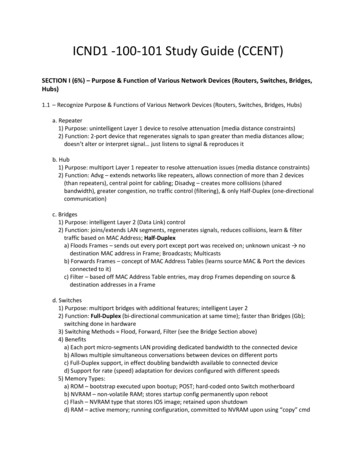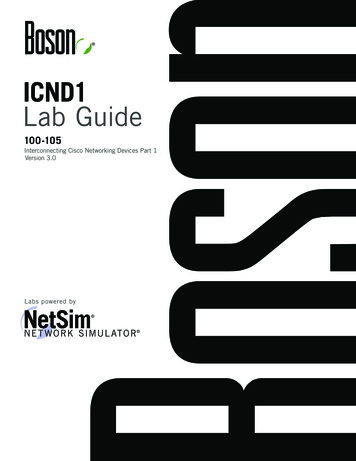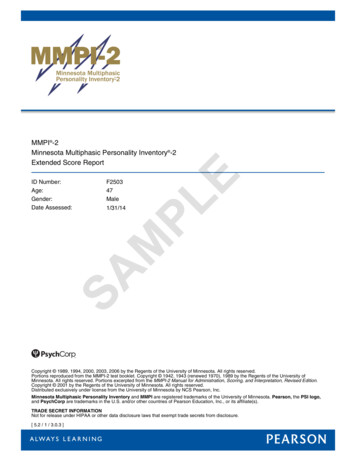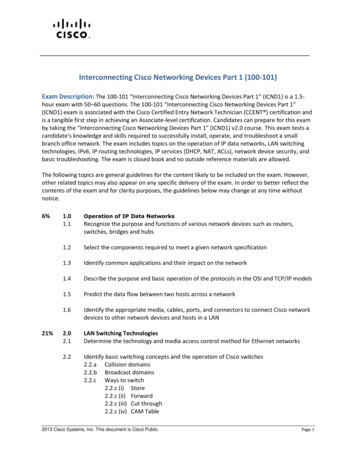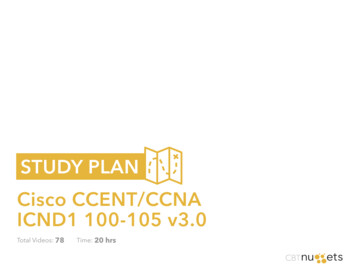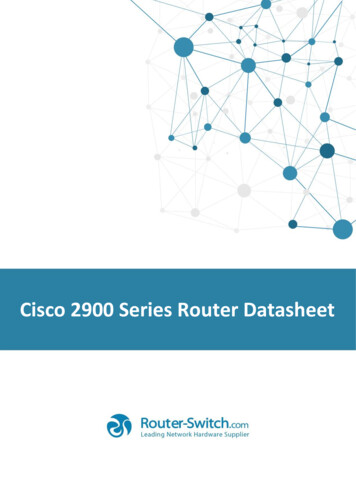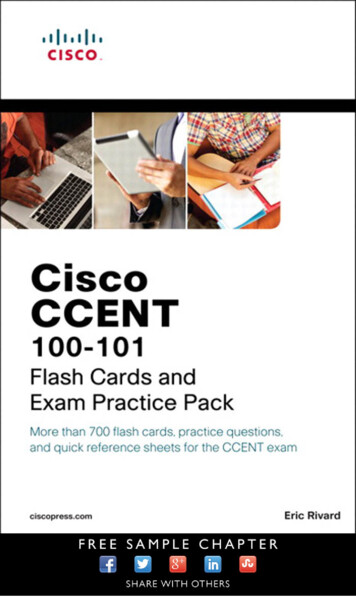
Transcription
Cisco CCENTICND1 100-101Flash Cards andExam Practice PackEric RivardCisco Press800 East 96th StreetIndianapolis, IN 46240 USA
iiCisco CCENT ICND1 100-101 Flash Cards and Exam Practice PackCisco CCENT ICND1 100-101 Flash Cards andExam Practice PackEric RivardCopyright 2013 Cisco Systems, Inc.Published by:Cisco Press800 East 96th StreetIndianapolis, IN 46240 USAAll rights reserved. No part of this book may be reproduced or transmitted in any form or byany means, electronic or mechanical, including photocopying, recording, or by any information storage and retrieval system, without written permission from the publisher, except for theinclusion of brief quotations in a review.Printed in the United States of America 1 2 3 4 5 6 7 8 9 0First Printing June 2013Library of Congress Control Number: 2013941282ISBN-13: 978-1-58720-399-2ISBN-10: 1-58720-399-5Warning and DisclaimerThis book is designed to provide information about late-stage preparation for the CiscoCCENT 100-101 Exam. Every effort has been made to make this book as complete and as accurate as possible, but no warranty or fitness is implied.The information is provided on an “as is” basis. The authors, Cisco Press, and Cisco Systems,Inc., shall have neither liability nor responsibility to any person or entity with respect to anyloss or damages arising from the information contained in this book or from the use of thediscs or programs that may accompany it.The opinions expressed in this book belong to the author and are not necessarily those ofCisco Systems, Inc.Trademark AcknowledgmentsAll terms mentioned in this book that are known to be trademarks or service marks have beenappropriately capitalized. Cisco Press or Cisco Systems, Inc. cannot attest to the accuracy ofthis information. Use of a term in this book should not be regarded as affecting the validity ofany trademark or service mark.
iiiCorporate and Government SalesThe publisher offers excellent discounts on this book when ordered in quantity for bulk purchases or special sales, which may include electronic versions and/or custom covers and contentparticular to your business, training goals, marketing focus, and branding interests. For moreinformation, please contact: U.S. Corporate and Government Sales 1-800-382-3419corpsales@pearsontechgroup.comFor sales outside of the U.S. please contact: International Sales international@pearsoned.comFeedback InformationAt Cisco Press, our goal is to create in-depth technical books of the highest quality and value.Each book is crafted with care and precision, undergoing rigorous development that involvesthe unique expertise of members from the professional technical community.Readers’ feedback is a natural continuation of this process. If you have any comments regardinghow we could improve the quality of this book, or otherwise alter it to better suit your needs,you can contact us through e-mail at feedback@ciscopress.com. Please make sure to include thebook title and ISBN in your message.We greatly appreciate your assistance.Publisher: Paul BogerBusiness Operation Manager, Cisco Press: Jan CornelssenAssociate Publisher: Dave DusthimerExecutive Editor: Brett BartowSenior Development Editor: Christopher A. ClevelandManaging Editor: Sandra SchroederCopy Editor: John EdwardsSenior Project Editor: Tonya SimpsonTechnical Editors: Brian D’Andrea, Desiree LindfieldEditorial Assistant: Vanessa EvansProofreader: Paula LowellBook Designer: Mark ShirarComposition: Mary Sudul
ivCisco CCENT ICND1 100-101 Flash Cards and Exam Practice PackAbout the AuthorEric Rivard is a professional services manager for CDW, overseeing an industryexpert team of consultants that implement advanced Cisco, Microsoft, data center,virtualization, and storage solutions to enterprise customers. Over the years, he hastaught professionals in both academic and industry settings on topics of SCADA,Windows, networking, and IT security. Eric has 15 years of experience in the ITindustry, ranging from a network administrator to senior Cisco engineer to IT director. Eric is also a professor at National University, teaching networking and IT classes. He is the author of the first, second, and third editions of the CCNA Flash CardPractice Pack.He holds a B.S. in Information Technology from the University of Phoenix and aMaster’s in Business Management Administration from Redlands University. Eric alsovolunteers serving the young men ages 12 through 18 in his church. Eric is an EagleScout and currently works with the Boy Scouts in his area. He lives with his wife andfive children in Oceanside, California.About the Technical ReviewersBrian D’Andrea started his career working as a bench technician for a large computermanufacturer. He then progressed to a consultant position for various financial andmedical institutions across Pennsylvania, New Jersey, and Delaware. He is now along-time instructor and courseware developer of Cisco courses that include CCNARouting & Switching, CCDA, CCNA Security, CCNP Routing & Switching, andCCDP. He has been privileged to be part of several Cisco Press–published materials. He enjoys sharing his knowledge and 17 years of experience in the InformationTechnology field.Desiree Lindfield is a Cisco Certified Systems Instructor (CCSI) and provides officialCisco training for Boson and Global Knowledge. She has delivered technical training for numerous vendors and technologies for teams located around the globe. Inaddition to training, Desiree serves on a team of consultants providing design, installation, and troubleshooting services. Recent implementations include Nexus 7000switches and the Cisco Unified Computing System. Desiree is a regular attendee ofCisco Live, B-Sides, and Defcon conferences.
AcknowledgmentsDedicationsI dedicate this edition to my beloved family: my beautiful wife, Tammy, and mychildren, Ellie, Collin, Reegin, Averie, and Sadie. I am the man I am today becauseof you. You are my everything! Tammy, I could not have found a more perfect partner to spend my life and all eternity with. I am deeply in love with you. Thank youfor your support, understanding, love, and patience. To my children, you are sucha blessing to your mother and me, and we love you more than you will ever know.Always remember how special you are. Always choose the right path and help others. I love you so much!Finally, I would like to dedicate this edition to my father-in-law, Paul M. Hatch.Thank you for your love, support, and righteous example through the years. I feel soblessed to be called your son. We love you. God be with you until we meet again.AcknowledgmentsFirst and foremost, I would like to thank my Father in Heaven for Your love and tender mercies. You have always been there for me. To my beautiful wife, thank you forbeing understanding during the long nights and hours I had to put in while workingon this edition. It is not easy raising five kids, let alone trying to do it on your ownwhile I was working late. You are an amazing mother and woman. To my children,everything I do, I do for you. Thank you for being such great kids. I am lucky to beyour father.To my parents, brothers, and in-laws. You guys are so amazing and I love you dearly.I am truly blessed to have you in my life.To Brett Bartow, Executive Editor, thank you for your efforts in ensuring that thisproject was a success. It is always a pleasure to work with you.To Christopher Cleveland, thank you for your efforts and working with me on thisedition.To the team at Cisco Press that helped with all the behind-the-scenes work to makethis edition happen, thank you. To the technical reviewers, Brian and Desiree, thankyou for your hard work and time. Your efforts were paramount.v
viCisco CCENT ICND1 100-101 Flash Cards and Exam Practice PackContentsIntroductionixSection 1Exploring the Functions of Networking2Section 2Introducing Local-Area NetworksSection 3Understanding Ethernet and Switch OperationsSection 4Understanding TCP/IPSection 5RoutingSection 6Managing Traffic Using Access ListsSection 7Enabling Internet ConnectivitySection 8Managing Network Device SecuritySection 9Implementing VLANs and TrunksSection 10WAN TechnologiesSection 11Implementing OSPFSection 12Introducing IPv6350ICND1 Quick Reference Guide3763813017231033220823024628098
NSwitchAccessServerDSU/CSUPersonalComputerFile ServerModemData Service Unit/Channel Service UnitNetwork SwitchWAN CloudVLANHubNetwork Cloud orBroadcast DomainEthernetFast EthernetSerial LineCircuit SwitchedLineAccessPointWireless ConnectionCommand Syntax ConventionsThe conventions used to present command syntax in this book are the same conventions used in the IOS Command Reference. The Command Reference describes theseconventions as follows: Boldface indicates commands and keywords that are entered literally, as shown. Inactual configuration examples and output (not general command syntax), boldfaceindicates commands that are manually input by the user (such as a show command). Italics indicate arguments for which you supply actual values. Vertical bars ( ) separate alternative, mutually exclusive elements. Square brackets [ ] indicate optional elements. Braces { } indicate a required choice. Braces within brackets [{ }] indicate a required choice within an optional element.
viiiCisco CCENT ICND1 100-101 Flash Cards and Exam Practice PackIntroductionSince the Cisco career certification programs were announced in 1998, they havebeen the most sought-after and prestigious certifications in the networking industry.For many, passing the ICND exams is crucial in building a rewarding career in networking or obtaining career advancement.Notorious as being some of the most difficult certifications in the networking industry, Cisco exams can cause much stress to the ill-prepared. Unlike other certificationexams, the Cisco exams require that students truly understand the material instead ofjust memorizing answers. This pack is best used after you have used another, primarymethod of study for the CCENT certification and need a mode of self-assessmentand review to bring you confidently to test day.The Purpose of Flash CardsFor years, flash cards have been recognized as a quick and effective study aid. Theyhave been used to complement classroom training and significantly boost memoryretention.The flash cards in this pack serve as a final preparation tool for the CCENT exam.They work best when used in conjunction with official study aids for the CCENTexam. They might also be useful to you as a quick desk- or field-reference guide.Who These Flash Cards Are ForThese flash cards are designed for network administrators, network engineers, CiscoNetworking Academy Program students, and any professional or student looking toadvance his or her career through achieving Cisco CCENT certification.How to Use These Flash CardsReview one section at a time, reading each flash card until you can answer it correctly on your own. When you can correctly answer every card in a given section,move on to the next.These flash cards are a condensed form of study and review. Don’t rush to movethrough each section. The amount of time you spend reviewing the cards directlyaffects how long you’ll be able to retain the information needed to pass the test. Acouple of days before your exam, review each section as a final refresher. Althoughthese flash cards are designed to be used as a final-stage study aid (30 days beforethe exam), they can also be used in the following situations: Pre-study evaluation: Before charting out your course of study, read one or twoquestions at the beginning and end of every section to gauge your competence inthe specific areas. Reinforcement of key topics: After you complete your study in each area, readthrough the answer cards (on the left side of the pages) to identify key topics andto reinforce concepts.
Quick Reference Guide Identify areas for last-minute review: In the days before an exam, review thestudy cards and carefully note your areas of weakness. Concentrate your remaining study time on these areas. Post-study quiz: By flipping through this book at random and viewing the questions on the right side of the pages, you can randomize your self-quiz to be surethat you’re prepared in all areas. Desk reference or field guide to core concepts (Quick Reference Guide sectiononly): Networking professionals, sales representatives, and help-desk techniciansalike can benefit from a handy, simple-to-navigate book that outlines the majortopics aligned with the CCENT certification.Quick Reference GuideAfter the flash cards, you will find the Quick Reference Guide, which can serve asboth a study guide for the CCENT exam and as a companion reference to the text.For readers who seek CCENT certification, this Quick Reference Guide is wellsuited to reinforce the concepts learned in the text rather than as a sole source ofinformation. For readers who have either already obtained CCENT certificationor simply need a basic overview, the study sheets in this guide can serve as a standalone reference.What Is Included on the CD-ROMThe CD-ROM included with this book provides you with access to the Pearson ITCertification Practice Test (PCPT) software as well as the Pearson IT CertificationFlash Cards Online application.The PCPT software comes complete with more than 150 exam-realistic practice testquestions that help you assess your knowledge and exam readiness. The software isfully customizable, enabling you to focus on individual topic areas or take completed,timed exams. You can work in study mode, which allows you to review answers andfull explanations, or in practice exam mode, which simulates the actual exam experience. You can take notes on questions or bookmark questions to create your owncustom question databases. This powerful assessment engine also tracks your performance and provides feedback on a chapter-by-chapter basis, laying out a completeassessment of your knowledge to help you focus your study where it is needed most.The Cert Flash Cards Online allows you to access all the flash cards from the bookin a customizable online application. This flexible application lets you enter youranswer to each question and compare what you entered to the correct answer. Youcan choose to view cards in order or at random, and you can create custom sets fromthe entire bank of cards. The engine provides you with the ability to mark each question correct or incorrect and provides a detailed score report by category for eachsession. You can even write notes on each question and then get a printable PDF ofall your notes aligned to the relevant questions. Best of all, the application is accessible by any device that has an Internet connection, allowing you to study at homeon your desktop or on the go on your smartphone or tablet.ix
This page intentionally left blank
Section 3Understanding Ethernet andSwitch OperationsEthernet is the technology of choice for today’s LANs. It is fast, has low costs,and is easy to maintain. Today’s Ethernet standards support speeds of 10 Mbps,100 Mbps, 1 Gbps, 10 Gbps, and 40 Gbps.Ethernet functions at Layers 1 and 2 of the Open Systems Interconnection (OSI)model. As such, Ethernet standards specify cabling, signaling, and data link layeraddressing.Because most LANs use Ethernet as the primary Layer 2 technology, most switches today are Ethernet switches. This section covers the fundamentals of Ethernettechnologies and describes how switches operate.
Section 3: Understanding Ethernet and Switch OperationsQuestion 1What does BASE mean in 100BASE-T and 1000BASE-T?Question 2What is carrier sense multiple access collision detect(CSMA/CD)?Question 3What is UTP cabling?99
100Cisco CCENT ICND1 100-101 Flash Cards and Exam Practice PackAnswer 1BASE in 100BASE-T and 1000BASE-T refers to the baseband signaling method.Baseband is a network technology in which only one carrier frequency is used. Thismeans that when a device transmits, it uses the entire bandwidth on the wire anddoes not share it during the single time interval.Answer 2CSMA/CD describes the Ethernet access method.In CSMA/CD, many stations can transmit on the same cable, and no station has priority over any other. Before a station transmits, it listens on the wire (carrier sense)to make sure that no other station is transmitting. If no other station is transmitting,the station transmits across the wire. If a collision occurs, the transmitting stationsdetect the collision and run a random backoff algorithm. The random backoff algorithm is a random time that each station waits before retransmitting.Answer 3Unshielded twisted-pair (UTP) cabling is a type of twisted-pair cable that reliessolely on the cancellation effects produced by the twisted wire pairs to limit electromagnetic interference (EMI) and radio frequency interference (RFI).UTP cable is often installed using an RJ-45 connector, and UTP cabling must followprecise specifications dictating how many twists are required per meter of cable. Theadvantages of UTP are ease of installation and low cost. A disadvantage of UTP isthat it is more prone to EMI than other types of media.
Section 3: Understanding Ethernet and Switch Operations101Question 4What is the maximum cable length for UTP?Question 5What is a straight-through Ethernet cable, and when would youuse it?Question 6What is a crossover Ethernet cable, and when would you use it?
102Cisco CCENT ICND1 100-101 Flash Cards and Exam Practice PackAnswer 4The maximum length is 100 meters or 328 feet.Answer 5A straight-through Ethernet cable is wired the same way at both ends. This cableuses pins 1, 2, 3, and 6. The send and receive wires are not crossed.You should use a straight-through Ethernet cable when connecting dissimilar devices(for example, data terminal equipment [DTE] to data communications equipment[DCE]). Examples include connecting PCs (DTE) to switches or hubs (DCE) or arouter (DTE) to a switch or a hub (DCE).Answer 6A crossover Ethernet cable is a cable that has the send and receive wires crossed atone of the ends. In a Category 5 cable, the 1 and 3 wires are switched and the 2 and6 wires are switched at one end of the cable.You should use a crossover cable when connecting similar devices (DCE to DCE orDTE to DTE), such as connecting a router to a router, a switch to a switch or hub, ahub to a hub, or a PC to a PC.NOTE In today’s networks, most Catalyst switches have auto-mdix, which canautomatically detect the type of cable connected to the interface and automaticallyconfigure the connection appropriately.
Section 3: Understanding Ethernet and Switch OperationsQuestion 7What are the different UTP categories?Question 8What is the difference between single-mode fiber (SMF) andmultimode fiber (MMF)?Question 9What are three ways that LAN traffic is transmitted?103
104Cisco CCENT ICND1 100-101 Flash Cards and Exam Practice PackAnswer 7The categories of UTP cable are as follows: Category 1: Used for telephone communications. Category 2: Capable of data transmission speeds of up to 4 Mbps. Category 3: Used in 10BASE-T networks. Speeds up to 10 Mbps. Category 4: Used in Token Ring networks. Speeds up to 16 Mbps. Category 5: Capable of data transmission speeds of up to 100 Mbps. Category 5e: Supports speeds of up to 1 Gbps. Category 6: Consists of four pairs of 24-gauge copper wires. Speeds up to 1 Gbps. Category 6a: Supports speeds up to 10 Gbps.Answer 8The primary difference between SMF and MMF is the ability of the fiber to sendlight for a long distance at high bit rates. In general, MMF supports shorter distancesthan SMF.Answer 9LAN traffic is transmitted one of the following three ways: Unicast: Unicasts are the most common type of LAN traffic. A unicast frame is aframe intended for only one host. Broadcast: Broadcast frames are intended for all hosts within a broadcast domain.Stations view broadcast frames as public service announcements. All stationsreceive and process broadcast frames. Multicast: Multicasts are traffic in which one transmitter tries to reach only a subset, or group, of the entire segment.
Section 3: Understanding Ethernet and Switch OperationsQuestion 10How many bits are in an Ethernet address?Question 11What portion of the MAC address is vendor specific?Question 12What portion of the MAC address is vendor assigned?105
106Cisco CCENT ICND1 100-101 Flash Cards and Exam Practice PackAnswer 10Also called a MAC address, an Ethernet address is the Layer 2 address associatedwith the Ethernet network adapter. Typically burned into the adapter, the MACaddress is usually displayed in a hexadecimal format, such as 00-0d-65-ac-50-7f.Answer 11The first half or first 24 bits of the MAC address are vendor specific.A MAC address is 48 bits and is displayed in hexadecimal. The first half of theaddress identifies the vendor or manufacturer of the card. This is called theOrganizational Unique Identifier (OUI). The last half of the address identifies thecard address.Answer 12The last 24 bits are vendor assigned.
Section 3: Understanding Ethernet and Switch OperationsQuestion 13What are the first 24 bits in a MAC address called?Question 14What is an example of a Layer 2 address?Question 15What is an example of a Layer 3 address?107
108Cisco CCENT ICND1 100-101 Flash Cards and Exam Practice PackAnswer 13These bits are the Organizational Unique Identifier (OUI).Answer 14An example is a MAC address.Answer 15An example is an IP address.
Section 3: Understanding Ethernet and Switch Operations109Question 16If a sending device does not know the MAC address of thedestination device, what protocol is used to find the MACaddress of the receiving device?Question 17Host A wants to send data to host B. Host B is on a differentsegment from host A. The two segments are connected to eachother through a router. What will host B see as the source MACaddress for all frames sent from host A?Question 18Switching uses a process outlined by the IEEE as transparentbridging. What are the five processes transparent bridges usefor determining what to do with a frame?
110Cisco CCENT ICND1 100-101 Flash Cards and Exam Practice PackAnswer 16Address Resolution Protocol (ARP) is used to find the MAC address of the receivingdevice.ARP is a local broadcast sent to all devices on the local segment to find the MACaddress of a host.Answer 17Because host B is on a different segment that is separated by a router, the MACaddress of all frames sent from host A will be the MAC address of the router.Anytime a frame passed through a router, a router rewrites the MAC address to theMAC address of the router’s exit interface for the segment and then sends the frameto the local host.In this case, the router will change the source MAC address of the frame sent fromhost A with the MAC address of its interface connecting to the segment host B is on.Host B will see that the frame came from the MAC address of the router with the IPaddress of host A.Answer 18The five processes of transparent bridging as defined in IEEE 802.1d are1. Learning2. Flooding3. Filtering4. Forwarding5. Aging
Section 3: Understanding Ethernet and Switch OperationsQuestion 19What is the transparent bridging learning process?Question 20What is the transparent bridging flooding process?Question 21What is the transparent bridging filtering process?111
112Cisco CCENT ICND1 100-101 Flash Cards and Exam Practice PackAnswer 19When a frame enters a switch, the switch adds the source Ethernet MAC address andsource port into its MAC address table. The process of recording the source MACaddress and the source port in the table whenever a switch sees a frame is called thelearning process.Answer 20When a switch receives a unicast frame and it does not have the destination MACaddress and port in its bridging table, or a broadcast or multicast frame, the switchwill forward this frame out all ports, except the port it received the unicast frame on.This is called the flooding process.Answer 21The filtering process occurs when a switch receives a frame and the source and destination hosts reside on the same interface. When this occurs, the switch filters ordiscards the frame.
Section 3: Understanding Ethernet and Switch Operations113Question 22What is the transparent bridging forwarding process?Question 23What is the transparent bridging aging process?Question 24For what two purposes does the Ethernet protocol use physicaladdresses?
114Cisco CCENT ICND1 100-101 Flash Cards and Exam Practice PackAnswer 22A switch forwards a frame when the destination address is in the switch’s MACaddress table and the source and destination are on different interfaces. This is theforwarding process.Answer 23When a switch learns a source address, it time-stamps the entry in the MAC addresstable. Every time the switch sees a frame from the same source, the timestamp isupdated. The aging process occurs when the switch does not see a frame from thesource before the aging timer expires. When this happens, the switch removes theentry from the MAC address table.Answer 24Ethernet uses physical addresses to Uniquely identify devices at Layer 2 Allow communication between different devices on the same Layer 2 network
Section 3: Understanding Ethernet and Switch OperationsQuestion 25What will an Ethernet switch do if it receives a unicast framewith a destination MAC that is listed in the switch table?Question 26Under what conditions would a switch flood a frame?115
116Cisco CCENT ICND1 100-101 Flash Cards and Exam Practice PackAnswer 25The switch will forward the frame to a specific port.Switches use the transparent bridging process to determine how to handle frames.The process is as follows:1. A frame is received.2. If the destination is a broadcast or multicast, the switch will forward the frame toall ports except to the port the frame was received.3. If the destination is a unicast and the address is not in the MAC address table,the switch forwards the frame to all ports except the receiving port.4. If the destination is a unicast, the address is in the MAC address table, and theassociated interface in the MAC address table is not the receiving interface, theswitch forwards the frame to the correct interface.5. If the above rules do not occur, filter the frame.Answer 26A switch will flood a frame if the MAC address table is full, if the destination MACaddress has not been learned by the switch, or if the frame is a broadcast or multicast frame.
Section 3: Understanding Ethernet and Switch OperationsQuestion 27What is the switch MAC address table used for?Question 28Describe full-duplex transmission.117
118Cisco CCENT ICND1 100-101 Flash Cards and Exam Practice PackAnswer 27The switch MAC address table forwards traffic out the appropriate interface.Because switches operate at Layer 2 of the OSI model, they switch traffic by MACaddress. Instead of flooding traffic out all interfaces, a switch learns the MACaddress of devices on each interface and only forwards traffic destined to the hoston the interface. The learned MAC addresses are stored in the switch’s MAC addresstable.Answer 28Full-duplex transmission is achieved by setting switch interfaces, router ports, andhost NICs to full duplex. Microsegmentation, where each network device has itsown dedicated segment to the switch, ensures that full duplex will work properly.Because the network device has its own dedicated segment, it does not have toworry about sharing the segment with other devices. With full-duplex transmission,the device can send and receive at the same time, effectively doubling the amount ofbandwidth between nodes.Three points to remember about the operation of full-duplex communication are There are no collisions in full-duplex mode. A dedicated switch port is required for each full-duplex node. The host network card and the switch port must be capable of operating in fullduplex mode.
Section 3: Understanding Ethernet and Switch OperationsQuestion 29What are the advantages of using full-duplex Ethernet insteadof half-duplex?Question 30How does replacing a hub with a switch affect CSMA/CDbehavior in an Ethernet network?119
120Cisco CCENT ICND1 100-101 Flash Cards and Exam Practice PackAnswer 29Full-duplex provides faster data transfer by being able to send and receive simultaneously and operates without collisions.NOTE By enabling full-duplex on a port, you are disabling CSMA/CD on thesegment.Answer 30It effectively eliminates collisions.Replacing a hub with a switch effectively eliminates collisions because each switchport is a separate collision domain. One device per switch port and configured forfull-duplex operation eliminates the need for CSMA/CD.
Section 3: Understanding Ethernet and Switch Operations121Question 31What command allows you to view the duplex and speedsettings configured for a switch port?Question 32Can a network hub be connected to a switch port in full-duplexmode?
122Cisco CCENT ICND1 100-101 Flash Cards and Exam Practice PackAnswer 31To view the duplex and speed setting configured for a switch port, enter the showinterface interface-id command, as follows:Cat2960# show interface f0/1FastEthernet0/1 is up, line protocol is upHardware is Fast Ethernet, address is 0019.e81a.4801(bia 0019.e81a.4801)MTU 1500 bytes, BW 10000 Kbit, DLY 1000 usec,reliability 255/255, txload 1/255, rxload 1/255Encapsulation ARPA, loopback not setKeepalive set (10 sec)Auto-duplex, Auto-speed, media type is 10/100BaseTXinput flow-control is off, output flow-control is unsupportedARP type: ARPA, ARP Timeout 04:00:00Answer 32No. Because a hub shares access to the segment, it must connect to a switch port inhalf-duplex mode to be able to detect collisions.NOTE CSMA/CD is not enforced when full-duplex is configured.
Section 3: Understanding Ethernet and Switch Operations123Question 33When troub
This book is designed to provide information about late-stage preparation for the Cisco CCENT 100-101 Exam. Every effort has been made to make this book as complete and as accu-rate as possible, but no warranty or fitness is implied. The information is provided on an “as is” basis. The authors, Cisco Press, and Cisco Systems,
